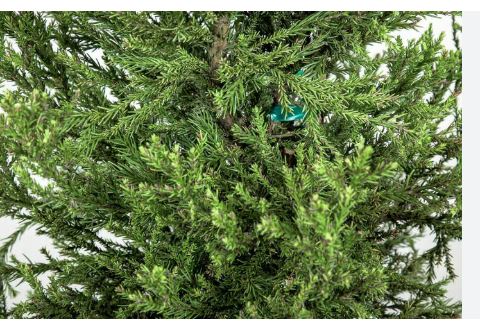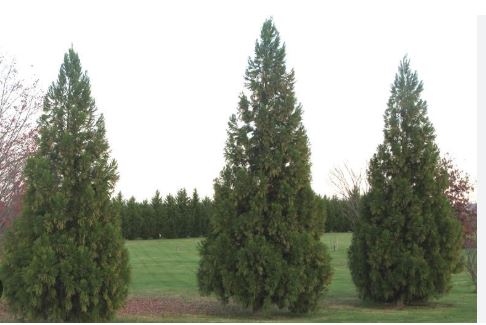
Cryptomeria Radicans, commonly referred to as Radicans Japanese Cedar, is a cultivar of Cryptomeria japonica, the sole species in the monotypic genus Cryptomeria. It belongs to the Cupressaceae family, which encompasses other conifers like cypresses, junipers, and sequoias. Despite its common name, it’s not a true cedar (genus Cedrus), but its wood and form align it with that aesthetic. Classified under the order Pinales, Cryptomeria is a gymnosperm, producing naked seeds in small cones. The ‘Radicans’ cultivar is distinguished from the species by its specific growth traits, though it shares the same taxonomic lineage as a woody, needle-leaved evergreen native to East Asia.
The history of Cryptomeria Radicans ties closely to its parent species, Cryptomeria japonica, which has been cherished in Japan for centuries as a timber tree and sacred planting around shrines. While the species was introduced to Western horticulture in the 1840s, ‘Radicans’ emerged later as a cultivated variety, likely selected for its faster growth and denser habit. Its development is less documented than the species, but it gained traction in the U.S. and beyond during the 20th century as landscapers sought reliable evergreens for privacy and ornamentation. Bred for resilience and aesthetic appeal, it reflects the long-standing Japanese tradition of refining Cryptomeria for practical and visual purposes.
Cryptomeria japonica, the parent of ‘Radicans’, is native to Japan’s mountainous regions and parts of southern China, though its wild status in China is debated. The ‘Radicans’ cultivar, however, is a product of horticultural selection, not found naturally. Since its introduction to North America and Europe, it has been widely distributed through the nursery trade, thriving in temperate landscapes rather than naturalizing. Its cultivation spans from suburban yards to commercial properties, with significant use in the southeastern and western U.S., where its adaptability to varied soils and climates shines. Birds and wind don’t spread it like invasives—it’s a deliberate planting choice.
Cryptomeria Radicans stands out with its soft, feathery, needle-like foliage, spiraling around branchlets in a dense, dark green cloak that shifts to a subtle bluish or bronze tint in winter. Growing in a narrow, pyramidal form, it reaches 30–50 feet tall and 10–20 feet wide at a brisk 3–4 feet per year, faster than many Cryptomeria cultivars. Its reddish-brown bark peels in thin strips, adding texture, while small, round cones (about an inch wide) dot the tips, though they’re less prominent than the foliage. Unlike some relatives, it resists tip blight and maintains a strong central leader, giving it a tidy, upright silhouette without much pruning.
This cultivar flourishes in USDA Zones 5 to 9, handling cold snaps down to -20°F (-29°C) and tolerating moderate summer heat. It’s most vigorous in Zones 6–8, where winters are mild enough to avoid severe needle burn and summers aren’t oppressively humid. Well-drained, slightly acidic soils (pH 5.5–6.5) suit it best, and it needs shelter from harsh winds in colder zones to stay lush. In hotter climates, partial shade can prevent stress, making it versatile across a broad swath of North America.
Cryptomeria Radicans is a landscaping dynamo, prized for its rapid growth and evergreen density. It’s a top pick for privacy screens or windbreaks, with its tight, feathery foliage forming a living wall when planted 8–10 feet apart—perfect for blocking neighbors or noise. As a specimen tree, its elegant pyramid shape anchors large yards or frames patios, while its deer resistance and low upkeep appeal to hands-off gardeners. In smaller spaces, it can line driveways or accent corners, though its height demands room to stretch. The soft texture and year-round color make it a standout, blending function with quiet sophistication.

Cryptomeria Radicans: Cultivation
Climate Compatibility
Cryptomeria Radicans thrives in USDA Zones 5 to 9, enduring lows to -20°F (-29°C) and handling moderate summer heat. It performs best in Zones 6–8, where winters are mild and summers avoid excessive humidity that stresses its foliage.
Sunlight Requirements
Plant in full sun for maximum growth and density—expect 3–4 feet of vertical gain yearly. It tolerates partial shade, especially in hotter climates, where afternoon protection prevents needle burn or drying out.
Soil Preferences
It prefers well-drained, slightly acidic soils (pH 5.5–6.5), like loamy or sandy mixes. Heavy clay or alkaline conditions hinder root health, so amend with peat or compost to boost drainage and acidity if needed.
Watering Needs
Keep soil evenly moist during the first two years to establish its shallow root system—water deeply weekly if rain is scarce. Once mature, it’s moderately drought-tolerant but benefits from occasional soaking during prolonged dry spells to maintain vigor.
Planting Time
Early spring or fall planting gives roots a head start before summer heat or deep freezes. Avoid midsummer transplants to minimize stress, though container-grown stock can go in anytime frost isn’t imminent.
Spacing
Space 8–10 feet apart for privacy screens or hedges, leveraging its 10–20-foot mature width. For standalone specimens, allow 15–20 feet to showcase its 30–50-foot height without crowding neighbors.
Fertilization
Apply a slow-release, acid-loving fertilizer (like 10-10-10 or 4-3-4) in early spring before new growth kicks in. One light feeding yearly suffices—overdoing it risks floppy, weak branches that spoil its tight form.
Mulching
Layer 2–3 inches of organic mulch (pine bark or wood chips) around the base to lock in moisture, cool roots, and deter weeds. Keep mulch an inch from the trunk to avoid rot or pest issues.
Pruning Practices
Minimal pruning is needed thanks to its strong central leader and natural pyramid shape. Trim dead or damaged tips in late winter with clean shears—avoid shearing heavily, as it won’t regrow from old wood.
Pest Management
Monitor for spider mites, which speckle needles yellow in dry heat—blast them with water or use horticultural oil. Scale and bagworms may appear; treat with insecticidal soap or hand-pick bags early to keep damage low.
Disease Prevention
Good drainage prevents root rot, while air circulation curbs leaf blight or fungal spots that brown needles in wet conditions. Remove fallen debris and water at the base, not overhead, to limit disease risk.
Winter Protection
In Zones 5–6, shield young plants from drying winds with burlap or anti-desiccant sprays—mature trees handle cold better but may bronze slightly. Brush off heavy snow to prevent branch bending, though it’s sturdier than many conifers.
Propagation
Propagate via semi-hardwood cuttings in late summer—take 6–8-inch tips, dip in rooting hormone, and root in a moist, sandy mix under high humidity. Seeds are rare and unreliable, so cuttings are the go-to for this cultivar.